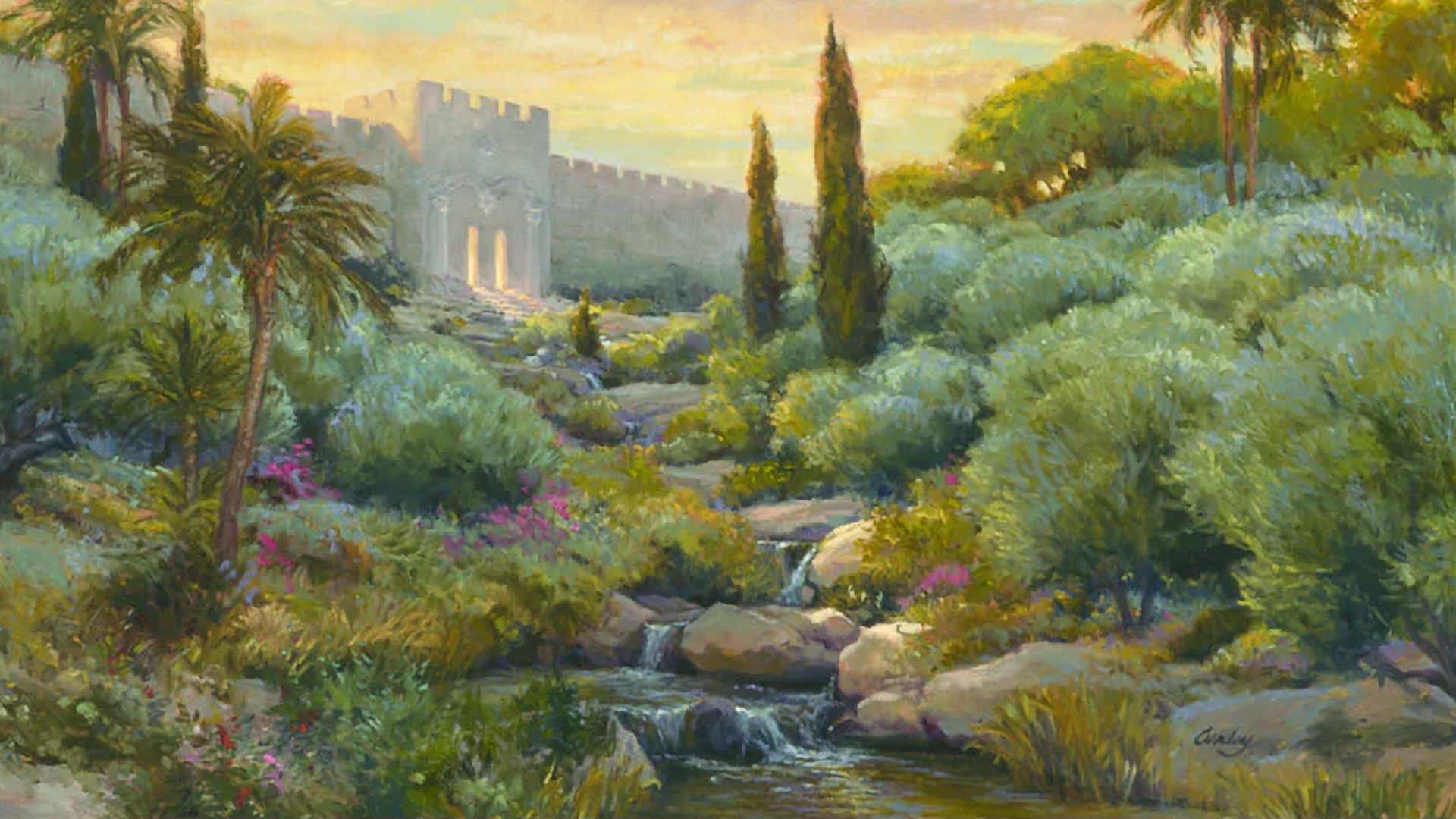You are here
How Can Jesus Provide to All People the Waters of Life?

John 4:14
The Know
As Jesus was travelling to Galilee, He rested at the deep Well of Jacob near a Samaritan village named Sychar. When a woman came out of the city to draw water, Jesus spoke with her, stating that unlike the well, He offered the world living water and that “whosoever drinketh of the water that I shall give him shall never thirst; but the water that I shall give him shall be in him a well of water springing up into everlasting life” (John 4:14).
The woman initially doubted Jesus’s authority, asking Him, “Art thou greater than our father Jacob?” (John 4:12). Yet she soon recognized Jesus as a prophet and then as the promised Messiah (John 4:19, 29). Because of her faith and contrite heart, Jesus identified Himself to be Jehovah, declaring, “I that speak unto thee am he” (John 4:26).
It may not be apparent in the King James Version, but the underlying Greek text uses the phrase “I am,” drawing to mind Moses’s encounter with the Lord on Mount Sinai, where “God said unto Moses, I AM THAT I AM” (Exodus 3:14). As such, this passage may be alternatively rendered as “I AM is speaking to you.”1 According to John W. Welch and Jeannie S. Welch, “Jesus’s declaration to the woman outside a village in Samaria is certainly one of the most famous, most important, and most unambiguous self-disclosures of His identity.”2
Jesus’s self-identification as Jehovah can also help readers better understand what He meant by declaring Himself to be the source of living waters. This concept has significant connections to the Israelite temple, where Jehovah would come to meet His people at the mercy seat (see Exodus 25:22). As Hugh Nibley has observed, temples in the ancient world contained basins or springs of water “from which four streams flowed out to bring the life-giving waters to the four regions of the earth.”3 Temples were purposefully designed to remind worshippers of the Garden of Eden, from which four rivers flowed out toward different regions of the earth (see Genesis 2:10–14).
The life-giving waters could also be seen as providing eternal life and sustenance to the children of God. John and Jeannie Welch have noted that Jesus’s statement to the woman “may have something to do with eternal progeny” due to His inviting the woman to bring her husband.4 Jesus may even have had in mind the Septuagint (LXX) Greek text of Numbers 5. That text explains that if a woman was suspected of infidelity, she could have her reputation cleared by attending the temple with her husband, where the woman would make an oath of her innocence before the priests. She would then be given a cup of “pure living water” to drink as a sign of her innocence (Numbers 5:17 LXX).5 By asking for the woman’s husband to come with her, Jesus may have been offering the woman a solemn opportunity to demonstrate her innocence or alternatively to repent and to fully partake of His Atonement, being then declared clean by the true and great High Priest—Jesus Himself (see Hebrews 3:1).
Jesus’s use of temple-related themes would have been especially significant for the Samaritan woman because Sychar was a village near Mount Gerizim, the traditional location of the Samaritan temple. Samaritans even had a temple there until it was destroyed in the Jewish conquest of Samaria under John Hyrcanus in 111–110 BC.6 However, unlike either of these temples that had been built at Jerusalem or Mount Gerizim, Jesus now identified Himself as the authentic and long awaited source of holy and permanent life-giving waters, as had been long symbolized in the temple.7 By extension, the covenant-centered church that Christ established (which helps bring people unto Him) could serve as another type of holy access for the whole world (see 1 Corinthians 3:16).
The Why
Practically all living things depend on water for life. Water provides essential nourishment, refreshment, and cleansing. In all these ways, pure, living water is an apt symbol for the exalting, eternal powers of Jesus Christ. Jesus Christ offered the Samaritan woman something much greater and more profound than any earthly or mortal blessing. Because she asked to be given this water, we can look to her example of exercising enabling faithfulness as she recognized Jesus as the incomparable Christ.
Moreover, this story emphasizes that Jesus is the true giver of eternal life. As water refreshes and nourishes us, Jesus Christ can offer our souls nourishment as we come to Him, worship Him, and make covenants with Him through baptism and temple ordinances. And, just as water can cleanse our bodies, Jesus Christ offers each and every one of us forgiveness, purification, and salvation. As Alma once taught the Nephites, “there can no man be saved except his garments are washed white; yea, his garments must be purified until they are cleansed from all stain, through the blood of him of whom it has been spoken by our fathers, who should come to redeem his people from their sins” (Alma 5:21).
Jesus is our Good Shepherd. He can heal us and provide us with the water of life because He knows us, His sheep. He leads us beside still waters as we hear and follow His voice. Elder Robert C. Gay has taught, “The power of [Jesus’s] Atonement is the power to overcome any burden in our life. The message of the woman at the well is that He knows our life situations and that we can always walk with Him no matter where we stand.”8 Whatever our individual circumstances, Jesus Christ is always there, a pure fountain of living waters to quench and purify our weary, needy souls.
Further Reading
John W. Welch and Jeanie S. Welch, The Parables of Jesus: Revealing the Plan of Salvation (American Fork, UT: Covenant Communications, 2019), 24–33.
Jackson Abhau, “John 2–4,” in New Testament Minute: John, ed. John W. Welch (Springville, UT: Scripture Central, 2022).
- 1. John W. Welch and Jeanie S. Welch, The Parables of Jesus: Revealing the Plan of Salvation (American Fork, UT: Covenant Communications, 2019), 25.
- 2. Welch and Welch, Parables of Jesus, 25.
- 3. Hugh Nibley, “The Hierocentric State,” in The Ancient State: The Rulers and The Ruled, ed. Donald W. Parry and Stephen D. Ricks (Provo, UT: Foundation for Ancient Research and Mormon Studies [FARMS]; Salt Lake City, UT: Deseret Book, 1991), 110; see also John Lundquist, “What Is a Temple? A Preliminary Typology,” in Temples of the Ancient World: Ritual and Symbolism, ed. Donald W. Parry (Provo, UT: FARMS; Salt Lake City, UT: Deseret Book, 1994), 88–89.
- 4. Welch and Welch, Parables of Jesus, 27. We are given no information about how old this woman was or how she came to be married five times. Some of her husbands may have died or may have divorced her. In any event, her situation was unusual, and her great needs had apparently drawn her closer to her ancestral roots near the well of Jacob and Rebecca, through whose lineage it was promised that the Messiah would come.
- 5. Welch and Welch, Parables of Jesus, 28.
- 6. This is briefly discussed in Welch and Welch, Parables of Jesus, 26.
- 7. See, for example, Matthew 12:6 and John 2:19–21.
- 8. Robert C. Gay, “Taking Upon Ourselves the Name of Jesus Christ,” October 2018 general conference.
KnoWhy Citation
Subscribe
Get the latest updates on Book of Mormon topics and research for free


